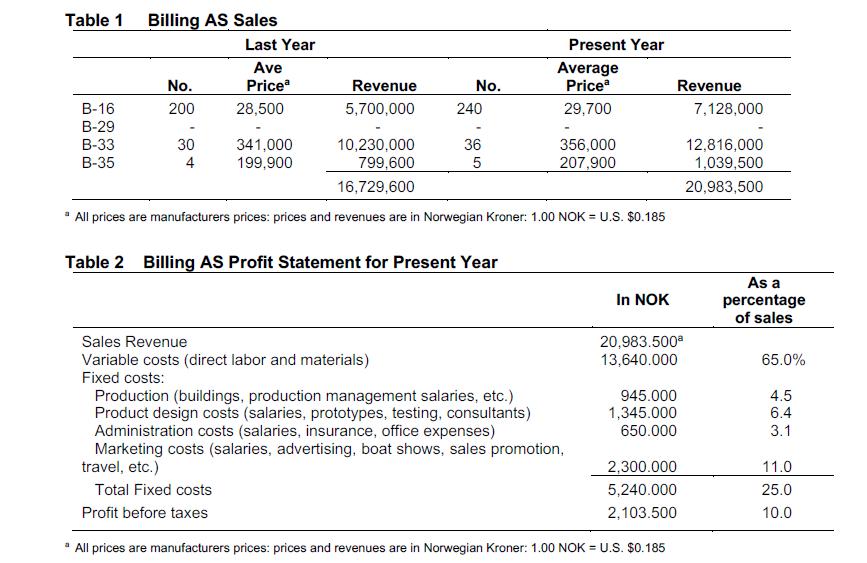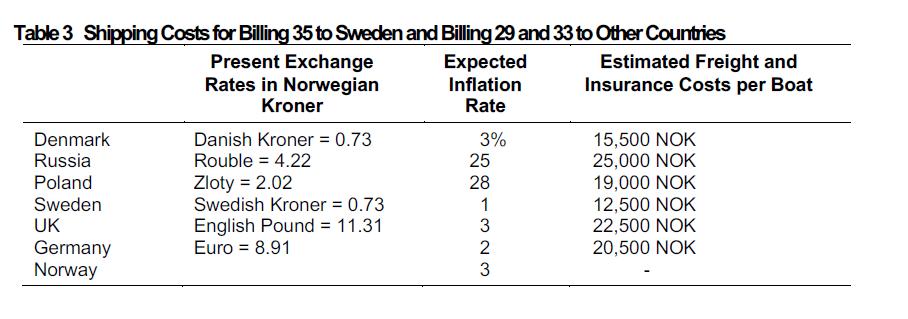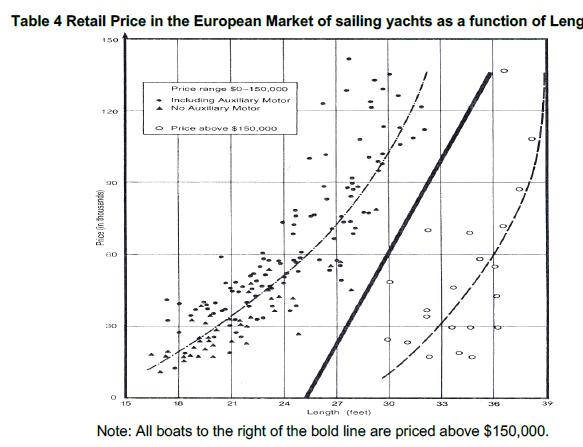Norway has a long tradition of boatbuilding stretching back to before Viking times. This is due, no doubt, to Norways proximity to the sea, ample
Norway has a long tradition of boatbuilding stretching back to before Viking times. This is due, no doubt, to Norway’s proximity to the sea, ample forests, and long coastline. Among luxury sailing yachts, the boats of Aker, Seil and Hyen are internationally known and admired. There are over 100 other boat builders in Norway that turn out 10,000 sailing yachts yearly. Although most Norwegian sailboat companies are situated on the south coast, Billing AS is located in the town of Steinkjer, roughly 450 kilometers northeast of Oslo. Billing was founded in the town partly because of the efforts of the Norwegian Regional Development Council, which provided a loan of twenty million Norwegian Crowns (Kroner, or NOK) to Billing AS, a privately owned company, to start its operations in the Nord Trøndelag area because of the region’s relatively high rate of unemployment.
The present product line consists of three fibreglass sailboats. The Billing 16 is a coastal sailing yacht with a new design approach. This approach is to provide a craft that enables a family to make weekend and holiday cruises in coastal waters and also offers exciting sailing. The sailboat is very fast. The Norwegian Yacht Racing Association stated in its test in which the Billing 16 was judged to be the best in her class: “She is delicate, lively, spacious, and easy to steer. She is well balanced and has a high-quality interior. She is especially fast on the beat and lively to handle in a free wind.” The B-16 has berths for two adults and two children, a sail area of 130 square feet, weighs one-half ton, and is a little over 16 feet long. The hull is made of glass-reinforced plastic (GRP), and the mast and boom are made of aluminium. The boat has a drop keel that is useful when negotiating shallow anchorages or when lifting the boat on a trailer.
The Billing 33 is a motor sailer that sleeps seven people in three separate compartments. The main saloon contains an adjustable dining table, a full galley, and a navigator’s compartment and is separated from the fore cabin by a folding door. The aft cabin, entered by a separate companionway, contains a double berth, wardrobe, and lockers. The toilet and shower are situated between the fore cabin and the main saloon. The boat has a sail area of 530 square feet, weighs about five tons, and has an overall length of 33 feet 5 inches. A significant feature of the craft is that she is equipped with a 35 horsepower diesel engine. The Billing 33 has the same design approach as the 16. She is well appointed, with sufficient space for seven people to live comfortably. An important feature is that the three separate living compartments allow for privacy. In addition however, the modern hull is quite sleek, making her an excellent sailing yacht.
The Billing 35 was designed for a different purpose. Whereas the 16 and 33 are oriented toward a family approach to sailing – combining the features of safety and comfortable accommodations with good sailing ability – the 35 is first and foremost a sailing craft. It has two births, a small galley, and toilet facilities, but the emphasis is on sailing and racing rather than comfort. The boat has a sail area of 420 square feet, weighs a little less than four tons, and has an overall length of 34 feet 6 inches. The boat is also equipped with a small (7 horsepower) diesel engine for emergency power situations. The Billing 35 is a traditional Swedish design and, therefore, is directed solely to the Swedish market.
Billing AS was established in order to manufacture sailboats for export. The Norwegian sailboat market is small because of the short sailing season. Even so, the company has been successful in marketing the 16 in Norway, though this was difficult in the beginning because of the lack of dealers. To solve this problem, Billing persuaded several new car dealers to handle the Billing 16 on an agency basis. This involved providing one boat to each car dealer to put in the showroom. The dealer then marketed the sailboats for a 25 percent sales commission. Though some scoffed at this idea, the system produced reasonable sales and also made the company known throughout Norway. This led to an
arrangement with one of the largest cooperative wholesale-retail operations in Norway. Like most cooperatives, this organization began with agricultural products: however, the product range of the company now includes virtually every conceivable consumer product. The present contract states that the cooperative will purchase eighty Billing 16 boats per year for the next three years.
The Swedish market is served by a selling agent, although this representative has not been particularly effective. Because Sweden is also the home of many sailboat builders, the company has tried to market only the 35 in that country. In Denmark, France, Holland, Germany and the United Kingdom, Billing has marketed the 33 through importers. These importers operate marinas in addition International Pricing and Performance 12 to selling new sailboats. They purchase the boats from Billing for their own accounts and mark up the price by 60 percent or more. In return for exclusive marketing rights in their respective countries, they agree to purchase a minimum number (usually three or four) of the 33 design per year. None of these importers is interested in marketing the 16 or the 35; the shipping cost for the 16 is too high compared with the value of the boat, and there is little customer interest in the 35.
Billing is planning to introduce a new sailboat. Whereas the present products were designed by people in the company who were relatively unknown (to the customers), the hull of the new sailboat has been designed by an internationally known boat designer. The cost of these design services was a $160,000 initial fee plus a $2,100 royalty fee to be paid for each boat produced. The new sailboat, the Billing 29, has an interior quite similar to that of the Billing 33 because the same people designed the interiors and decks of both sailboats.
The new boat is a motor sailer that sleeps six people in three separate compartments, is 28 feet 9 inches long, weighs 4 tons, and has a joined cabin space and a separate aft cabin, small galley, toilet and shower facilities, and a 22 horsepower diesel engine. Because a new construction technique greatly reduces the amount of fibreglass required, the variable costs to construct the boat are only 60 percent of the cost for the 33 With a preliminary selling price of 195,000 Norwegian Kroner, the Billing 29 is receiving very favourable attention, but the company is concerned that sales may have an adverse effect on sales of the 33.
The company categorizes the marketing expenses as fixed costs because allocating these expenses to specific products is difficult. The major element of the program is participation in international boat shows in London, Paris, Hamburg, Amsterdam, Copenhagen, and Oslo. The initial purpose of participating in these shows was to locate suitable importers in the target markets; however, this effort is maintained in order to support the marketing programs of the importers. The importers are also supported by advertising in the leading yachting magazines in national markets. Billing’s selling effort consists mostly of servicing the importers and agents and staffing the exhibitions at the boat shows. Most of the sales promotion costs are the result of the sales brochures that the company has developed for each boat. The costs are increased however by having to print a relatively small number of each brochure in Russian, Polish, French, English, German and Swedish. The brochures are provided to the agents and importers and are used at the boat shows.
Enter the Dragon
At a recent boat show held at Earl’s Court Exhibition Centre in London, after a long series of discussions, Billing’s company president received a proposal from the president of Sea Dragon Boats, a Chinese company located in the formerly Portuguese colony of Macau. The company is like Billing in that it sells several hundred traditional style sailing craft per year within China, and to the Chinese communities around Asia. But although the company has made boats in the traditional manner for over 200 years, it is beginning to shift its focus: from commercial coasting boats, to boats configured as luxury yachts, and from wood construction to fiberglass and composites. For that reason it recently built a modern fiberglass and composites production facility in Zhuhai Special Economic Zone (SEZ).
At Earl’s Court, Sea Dragon proposed entering into a 49-51 joint venture for Sea Dragon to produce the B-29 for the Chinese market. Billing would need to transfer its design and production expertise to Sea Dragon. In return, Sea Dragon would handle production and marketing across Asia for the B-29. The advantages of the JV are that Macau has direct linkages with the Zhuhai SEZ, in which taxes are not paid on goods that are exported, so export prices are generally competitively low. Sea Dragon also said that its production costs in Zhuhai would be 25 percent lower than Billing’s own Norwegian production cost, and suggested that this would make Chinese-produced boats profitable in the European market, even after transportation costs to Europe.
Sea Dragon had previously hosted Billing executives at the Macau Yacht show which demonstrated that there was rising demand for sailing yachts in Asia, that yachts were assuming a rather global character and style, and that Chinese buyers were keen to obtain the latest in yacht designs. Billing’s executives also felt the Chinese factory was suitable for production of the B-29, though the production workers would need careful training. International Pricing and Performance 13.
Going forward
The company is in the process of preparing its production and marketing plan for the coming year in order to arrange financing. The president is strongly committed to the continued growth of the company, and the market indications suggest that there is a reasonably strong demand for the 16 in Norway and for the 33 in most of the other national markets. The sales results of the previous and present years are shown in Table 1: the profit statement for the present year is shown in Table 2.
The main problem for next year is determining the price for each sailboat in each market. In previous years, Billing set its prices in Norwegian Kroner, on an ex-factory basis. Management has become convinced however that it must change the terms of its prices in order to meet competition in the foreign markets. Thus, the company has decided to offer CIF prices to its foreign customers in the currency of the foreign country. The use of truck ferries between Norway and Sweden, Denmark, Poland, Russia and Germany is expected to make this pricing approach more competitive.
Billing would also like to assure its agents and importers that the prices will remain in effect for the entire year, but the financial manager is concerned about the possible volatility of exchange rates because of the varying rates of inflation in the market countries. The present exchange rates, expected inflation rates, and the estimated costs to ship the Billing 35 to Stockholm and the Billing 29 and 33 to the other foreign marinas are shown in Table 3.A second difficulty in pricing the product line for Billing is to establish a price for the 29 that will reflect the value of the boat but will not reduce the sales of the 33. There are three schools of thought concerning the pricing of motor sailers. The predominant theory is that price is a function of the overall length of the sailboat. A number of people, however, believe that the overall weight of the craft is a much more accurate basis. The third opinion argues that price is a function of the special features and equipment. Table 4 was prepared by a Swiss market research firm and shows the relationship between present retail prices and the length of new motor sailers in the West European market.

Table 4 Retail Price in the European Market of sailing yachts as a function of Length Note: All boats to the right of the bold line are priced above $150,000.
Questions for Discussion
1. Determine the manufacturer’s selling price in the Norwegian market for all Billing sailboats for the coming year. Explain your rationale for setting prices.
2. Determine the CIF prices, in the foreign currencies for the B-29 and B-33 to the importers in Denmark, Sweden, Poland, the UK, Germany, and Russia.
3. Develop a production plan (how many of each type of boat) for Billing AS for the coming year. Support your plans by using relevant marketing metrics, e.g. sales, margins, company profits, etc.
4. Using your production plan, develop a projected profit statement for the coming year.
5. Should Billing enter the Joint Venture with Sea Dragon? If so, on what basis? Explain your answer thoroughly.
Table 1 Billing AS Sales Last Year Present Year Ave Average Price No. Price Revenue No. Revenue B-16 200 28,500 5,700,000 240 29,700 7,128,000 B-29 356,000 207,900 B-33 30 341,000 199,900 10,230,000 36 12,816,000 B-35 4 799,600 1,039,500 16,729,600 20,983,500 * All prices are manufacturers prices: prices and revenues are in Norwegian Kroner: 1.00 NOK = U.S. $0.185 Table 2 Billing AS Profit Statement for Present Year As a percentage of sales In NOK 20,983.500 13,640.000 Sales Revenue 65.0% Variable costs (direct labor and materials) Fixed costs: Production (buildings, production management salaries, etc.) Product design costs (salaries, prototypes, testing, consultants) Administration costs (salaries, insurance, office expenses) Marketing costs (salaries, advertising, boat shows, sales promotion, travel, etc.) 945.000 4.5 1,345.000 6.4 650.000 3.1 2,300.000 11.0 Total Fixed costs 5,240.000 25.0 Profit before taxes 2,103.500 10.0 * All prices are manufacturers prices: prices and revenues are in Norwegian Kroner: 1.00 NOK = U.S. $0.185
Step by Step Solution
3.42 Rating (155 Votes )
There are 3 Steps involved in it
Step: 1
ANSWERS 1 The price is a better fit with the customers perspective Valuebased pricing allows you to be more profitable meaning you can acquire more resources and grow your business When a price doesnt ...
See step-by-step solutions with expert insights and AI powered tools for academic success
Step: 2

Step: 3

Ace Your Homework with AI
Get the answers you need in no time with our AI-driven, step-by-step assistance
Get Started


